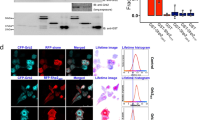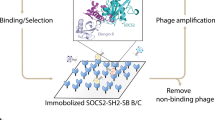Abstract
The proliferation and differentiation of cells of many lineages are regulated by secreted proteins known as cytokines. Cytokines exert their biological effect through binding to cell-surface receptors that are associated with one or more members of the JAK family of cytoplasmic tyrosine kinases. Cytokine-induced receptor dimerization leads to the activation of JAKs, rapid tyrosine-phosphorylation of the cytoplasmic domains, and subsequent recruitment of various signalling proteins, including members of the STAT family of transcription factors, to the receptor complex1,2,3,4,5. Using the yeast two-hybrid system, we have now isolated a new SH2-domain-containing protein, JAB, which is a JAK-binding protein that interacts with the Jak2 tyrosine-kinase JH1 domain6. JAB is structurally related to CIS, a cytokine-inducible SH2 protein7,8. Interaction of JAB with Jak1, Jak2 or Jak3 markedly reduces their tyrosine-kinase activity and suppresses the tyrosine-phosphorylation and activation of STATs. JAB and CIS appear to function as negative regulators in the JAK signalling pathway.
This is a preview of subscription content, access via your institution
Access options
Subscribe to this journal
Receive 51 print issues and online access
$199.00 per year
only $3.90 per issue
Buy this article
- Purchase on SpringerLink
- Instant access to full article PDF
Prices may be subject to local taxes which are calculated during checkout




Similar content being viewed by others
References
Miyajima, A., Kitamura, T., Harada, N., Yokota, T. & Arai, K. Cytokine receptors and signal transduction. Annu. Rev. Immunol. 10, 295–331 (1992).
Schindler, C. & Darnell, J. E. J Transcriptional responses to polypeptide ligands: the JAK–STAT pathway. Annu. Rev. Biochem. 64, 621–651 (1995).
Ihle, J. N. Cytokine receptor signalling. Nature 377, 591–594 (1995).
Ihle, J. N. STATs: Signal transducers and activators of transcription. Cell 84, 331–334 (1996).
Darnell, J. E. J., Kerr, I. M. & Stark, G. R. Jak–STAT pathways and transcriptional activation in response to IFNs and other extracellular signaling proteins. Science 264, 1415–1421 (1994).
Harpur, A. G., Andres, A. C., Ziemiecki, A., Aston, R. R. & Wilks, A. F. JAK2, a third member of the JAK family of protein tyrosine kinases. Oncogene 7, 1347–1353 (1992).
Yoshimura, A. et al. Anovel cytokine-inducible gene CIS encodes an SH2-containing protein that binds to tyrosine-phosphorylated interleukin-3 and erythropoietin receptors. EMBO J. 14, 2816–2816 (1995).
Matsumoto, A. et al. CIS, a cytokine inducible SH2 protein, is a target of the JAK–STAT5 pathway and modulates STAT5 activation. Blood 89, 3148–3154 (1997).
Schluter, G. et al. Sequence analysis of the conserved protamine gene cluster shows that it contains a fourth expressed gene. Mol. Reprod. Dvelop. 43, 1–6 (1996).
Kitayama, H. et al. Constitutively activating mutations of c-kit receptor tyrosine kinase confer factor-independent growth and tumorigenicity of factor-dependent hematopoietic cell lines. Blood 85, 790–798 (1995).
Feng, J. et al. Activation of JAK2 catalytic activity requires phosphorylation of Y1007 in the kinase activation loop. Mol. Cell. Biol. 17, 2497–2501 (1997).
Nakajima, K. et al. Acentral role for Stat3 in IL-6-induced regulation of growth and differentiation in M1 leukemia cells. EMBO J. 15, 3651–3658 (1996).
Kawahara, A., Minami, Y., Miyazaki, T., Ihle, J. N. & Taniguchi, T. Critical role of the interleukin 2 (IL-2) receptor gamma-chain-associated Jak3 in the IL2-induced c-fos and c-myc, but not bcl-2, gene induction. Proc. Natl Acad. Sci. USA 92, 8721–8728 (1995).
Vojtek, A. B., Hollenberg, S. M. & Cooper, J. A. Mammalian Ras interacts directly with serine/threonine kinase Raf. Cell 74, 205–214 (1993).
Briscoe, J. et al. Kinase-negative mutants of JAK1 can sustain interferon-γ-inducible gene expression but not an antiviral state. EMBO J. 15, 799–809 (1996).
Harper, J. W., Adami, G. R., Wei, N., Keyomarsi, K. & Elledge, S. J. The p21 Cdk-interacting protein Cip1 is a potent inhibitor of G1 cyclin-dependent kinase. Cell 75, 805–816 (1993).
Turner, D. L. & Weintraub, H. Expression of achaete-scute homolog 3 in Xenopus embryos converts ectodermal cells to a neural fate. Genes Dev. 8, 1434–1447 (1994).
Starr, R. et al. Afamily of cytokine-inducible inhibitors of signalling. Nature 387, 917–921 (1997).
Naka, T. et al. Structure and function of a new STAT-induced STAT inhibitor. Nature 387, 924–929 (1997).
Acknowledgements
We thank H. Ohgusu for technical assistance, T. Hirano for the APRE/jun promoter construct and STAT3 cDNA, R. Fukunaga for Jak2, A. F. Wilks for the Jak1, T. Shirasawa for rat Jak3 cDNAs, and D. Hilton and R. Starr for reading and editing the manuscript. Part of this work was supported by grants from the Ministry of Science, Education and Culture of Japan, the Kato Memorial Foundation, the Haraguchi Memorial Foundation, the Uehara Memorial Foundation, the Kowa Life Science Foundation, the Motida Memorial Science Foundation and the Naito Memorial Foundation.
Author information
Authors and Affiliations
Corresponding author
Rights and permissions
About this article
Cite this article
Endo, T., Masuhara, M., Yokouchi, M. et al. A new protein containing an SH2 domain that inhibits JAK kinases. Nature 387, 921–924 (1997). https://doi.org/10.1038/43213
Received:
Accepted:
Issue Date:
DOI: https://doi.org/10.1038/43213
This article is cited by
-
Proximal protein landscapes of the type I interferon signaling cascade reveal negative regulation by PJA2
Nature Communications (2024)
-
Targeting and regulation of autophagy in hepatocellular carcinoma: revisiting the molecular interactions and mechanisms for new therapy approaches
Cell Communication and Signaling (2023)
-
JAKs and STATs from a Clinical Perspective: Loss-of-Function Mutations, Gain-of-Function Mutations, and Their Multidimensional Consequences
Journal of Clinical Immunology (2023)
-
Diabetes as one of the long-term COVID-19 complications: from the potential reason of more diabetic patients’ susceptibility to COVID-19 to the possible caution of future global diabetes tsunami
Inflammopharmacology (2023)
-
Altered expression of SOCS genes periodontitis
BMC Oral Health (2022)



